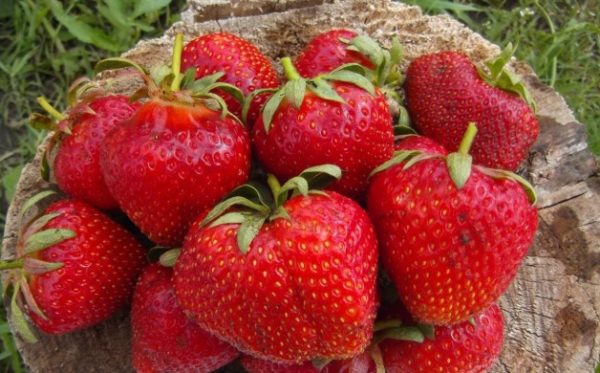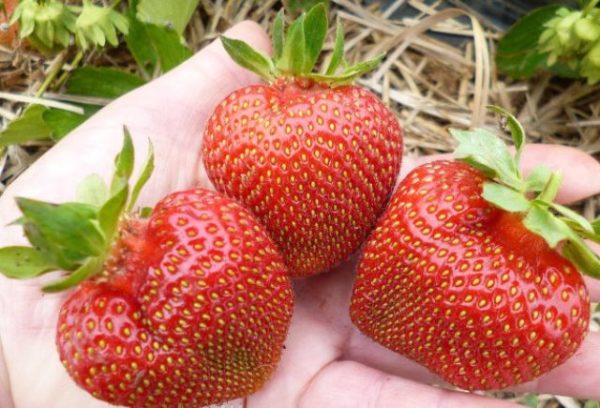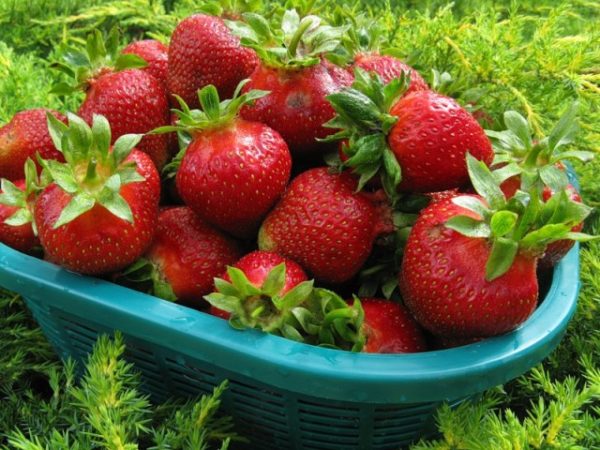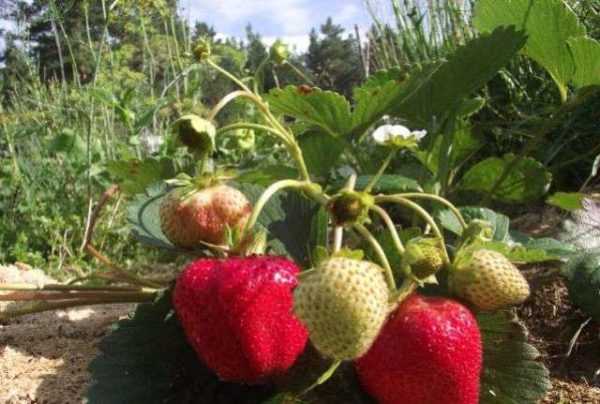Strawberry Cardinal - a new variety bred by American breeders. Berries have a high yield, they are juicy and sweet to the taste. Fruits tolerate transportation even over very long distances, berries can be harvested for the winter. Variety Cardinal is the best option for growing in garden plots.
Table of contents
Description of the strawberry variety Cardinal
Let's start with the description. Cardinal shrubs are not quite thick.but high, they reach 40–45 cm, with each one you can collect up to 1 kilogram of the crop.On the bushes grow dark green glossy leaves, they form a huge number of outlets. The peculiarity of this variety is that those rosettes, which bloomed and bore fruit, are not used for reproduction, because they do not take root. It is better to cut the tendrils so that the mother plant does not waste power.

The cardinal is a frost-resistant variety, it can be grown in regions with a harsh climate. In addition, plants are resistant to many diseases that affect garden plants. If the strawberry grows in the open field, it is desirable that the bushes in winter be covered with a thick snow layer, in such conditions the berry bushes will not freeze even a 35-degree frost.
Berries
Cardinal berries have an oval-conical shape, in their appearance they resemble a spindle with a rounded tip, in some berries it is bifurcated. The flesh of the fruit is quite hard dark red. The core is not fully filled, cavities are possible. The berries have a sweet and sour taste, reminiscent of the taste of strawberries. The surface of the strawberry is covered with small grains, painted in golden color.

The mass of one berry can be 80 grams.
Advantages and disadvantages
The variety has a variety of advantages. The most characteristic positive factors are:
- high yield, the plant can bear fruit several times in one season;
- fruits appear already in the first year after planting;
- the plant tolerates frost well, in connection with human, it can be grown in Siberia and cold regions;
- Bushes tolerate heat well and are drought-resistant varieties;
- The cardinal is good at resisting diseases that affect garden plants.
Breeding

Reproduction is carried out in different ways. Three options are most popular:
- breeding antennae;
- division of the bush;
- seeds.
Pre-landing is carried out in April. The best planting material is the antennae, which grew from the mother bush.
Saplings are planted in August; by the time of planting, they should have at least three full-fledged leaves and a well-developed root system. In the spring, the first fruits will appear on them. The first days of the bushes need to warm sheets of paper.
Landing rules
Strawberries prefer loamy, sandy, slightly acidic soil. Planting should begin at the end of the summer or early September. This approach will allow the bushes to take root firmly and adapt to new conditions before the first frosts appear.
There are two options for landing:

- bushes are planted in one row in the form of ribbonsbetween them maintain a distance of 60 cm, 20 cm should be left between the bushes, this method is ideal for spring or autumn planting, in this case you can get a lot of whiskers;
- planting bushes in 2 rowsThis method is very effective, it is best suited for summer planting, the bushes are placed in two rows of ribbons, 60 cm between the ribbons, and 20 cm between the bushes.
Landing should be well lit. Strawberries grow well in places where previously beets, onions, cabbage of any kind grew. Bushes need to be protected from wind and drafts. The plant is periodically fed. Berries require organic fertilizer. Best suited to a mixture of peat and humus. For prophylactic purposes, it is advisable to carry out spraying of copper sulfate.
Diseases and pests
The variety is fairly resistant to diseases, and yet, the plant can strike anthracnose, a disease caused by fungal microorganisms. If strawberries hit the disease, you can lose the harvest.

The cause of the development of the disease is improper watering. Fungi begin to actively develop at high humidity. The disease is defined by round, gray spots that cover the leaves and stems. With the development of all the individual spots begin to merge into one continuous spot.
Anthracnose leads to the fact that the twigs and berries begin to dry out. The cured form of the disease cannot be cured. The illness should be treated at the initial stage. The effective means in this case is spraying with the following means, like Antracol and Quadris.
Sometimes the plant affects powdery mildew. It develops both on the leaves, and on the fruits, and on the stems. As a result, a white fluffy bloom appears on the surface. This disease is not characteristic of strawberries, it usually affects those bushes that grow in the greenhouse. The cause of the disease is high humidity combined with high fever. The infected plant stops growing, the leaves begin to curl up into tubules. To combat the disease using Quadris and Fundazol.
TAlso on the strawberries can get a gray mold, all types of spotting and rot.
Cardinal is among the best varieties of strawberries. The plant can be grown even in regions with a cold climate. Before you start growing the Cardinal variety, you need to familiarize yourself with how to grow a plant. Proper care will allow you to get a rich harvest.
